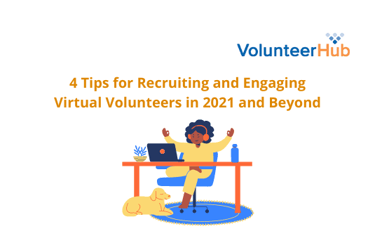Marketing Your Nonprofit: How to Reach and Engage Supporters
At first glance, marketing may seem strange for a nonprofit organization. The word calls to mind large corporations planning ad campaigns to generate profit. However, marketing your nonprofit is critical in supporting your organization’s mission.
The Benefits of Marketing Your Nonprofit
Nonprofit organizations understand that it takes a community to make a difference, and a strong marketing strategy will help you reach that community. Nonprofit marketing leverages advertising techniques to raise awareness about an organization.
A nonprofit marketing strategy can:
- Draw attention to your cause.
- Increase support for fundraising efforts.
- Recruit new volunteers.
- Engage potential donors.
- Nurture donor and volunteer relationships.
- Promote events, products, and services.
- Establish a stronger presence in your community.
And together, all of these factors allow your organization to make a greater impact.
Building Your Organization’s Brand
The first step to any marketing strategy is building a strong brand. Branding ensures that you convey your messages in a clear, effective manner, and it also helps your audience more easily recognize your organization and what it stands for.
- Start with your mission statement. As a nonprofit organization, your mission is the center of everything you do and will be the biggest influence on your branding and marketing. Keep your mission statement in mind through every step of the process.
- Target your marketing. Keep in mind what and who your organization needs. What do you want to achieve by marketing your nonprofit? Who are you trying to reach, and where are you most likely to find them? You can refine your goals for each new piece of marketing material.
- Craft a tagline. Adapt your mission statement into a simple, catchy tagline that you can use in marketing materials. A tagline will allow your audience to quickly understand and absorb your organization’s values.
- Develop a design style. Choose colors and fonts to reflect your organization’s brand and use them across all channels, including social media, websites, emails, and banners. A cohesive, consistent design style will solidify your brand in your audience’s minds and allow for speedy recognition. You can work with a professional graphic designer or use online tools like Canva to develop a brand design kit.
- Create a logo. Logos are a visual way to convey information about your organization. Develop a logo that represents your values and design style.
- Tell a story. Use the marketing materials you’ve developed to tell your organization’s story. Narratives hook audiences by engaging the emotions, so share specific examples of ways you have made a difference. Highlight individuals and augment the emotional content with data showcasing both the impact you have already made and the impact you are going to make!
Curate Your Online Presence
In our digital world, the Internet is one of the most important nonprofit marketing platforms, and optimizing your online presence is key to communicating with your audience.
Websites
Websites compile the most important information about your organization. After potential donors, volunteers, and customers hear about your nonprofit, your website will likely be their first stop. Therefore, your website must be accurate and professional.
- Make sure your website reflects your brand. Highlight your mission statement and organizational values. Once you have developed your brand design philosophy and created a new logo, use them on the website. You can work with a website developer or use website-building platforms like GoDaddy, Squarespace, or WordPress.
- Craft quality content. The writing on your website reflects your organization. Make sure you convey all information in a way that is clear and compelling. High-quality copy establishes a strong organizational reputation and communicates more effectively.
- Keep your website up-to-date. Highlight your most recent initiatives, link to active social media accounts, and ensure that all impact data and contact information are correct. Outdated information can make it look like your organization isn’t very active, and incorrect contact information provides an unnecessary stumbling block for potential supporters.
- Make it easy to get involved. Place calls to action on every page so that would-be donors can find a way to give and potential volunteers can start the application process. Create a blog. Blogs aren’t just great ways to maximize your reach on search engines; they are also important for showcasing your organization’s impact and values. Blog posts allow your audience to get to know you, what you care about, and what you do.
Social Media
Social media gives your organization a chance to make more personal connections with your audience. 72% of Americans use social media daily, so smart social media use is key to marketing your nonprofit.
- Develop a presence across different platforms. You can maximize your organization’s reach by posting content on multiple social media platforms. Facebook, YouTube, and Instagram are the most popular social media platforms, and utilizing all three will connect you with a broad audience. We also recommend considering TikTok, which is especially popular with younger demographics, X (formerly known as Twitter), and LinkedIn, a professional networking platform that can connect you with grantors, potential donors, and other nonprofits.
- Understand where to post your content. While some content can be cross-posted across different platforms, each social media platform has its unique strengths. You also want to be sensitive to supporters who may follow you across multiple sites, providing distinct content on each instead of just repeating posts.
- Facebook: Texts, graphics, and events
- YouTube: Video, with an emphasis on long-form videos
- Instagram: Images, informal story content, and short-form video
- TikTok: Short-form video
- X: Short text updates, photos, and links
- LinkedIn: Professional networking, articles, and links
- Develop quality content. Share content that your audience will find engaging. Social media is a great place to highlight leadership, volunteers, and donors, as personal stories invite your followers to imagine themselves in their place. Don’t shy away from humor or trends; they are great entry points for new followers.
- Utilize advertisement options. Many social media platforms offer robust analytics and affordable advertising options. You can use the platform to create targeted ads that address specific demographics like age and location. You can also use ads to link to event pages and products.
Landing Pages
Landing pages aren’t just for conveying information about your events; they are also important online marketing opportunities. Someone could visit a landing page because they are interested in a single event and turn into a core member of your volunteer base! In addition to incorporating your brand design kit and conveying all the relevant event information, make sure your event landing pages include your mission, other current initiatives, and links to your website, social media, and registration and donation forms.
Marketing Strategies for Nonprofits
Once you’ve built a cohesive brand and a strong online presence, you can start using marketing techniques to reach your audience.
Search Engine Optimization (SEO)
Many nonprofit supports will begin their journey on a search engine, so it’s important that they can find you there. Search engine optimization, also known as SEO, is a series of best practices to ensure your website and social media content rank higher in search results. It positions your nonprofit for organic engagement.
Search engine algorithms rank trusted resources on a topic higher in search results. To improve your organizational SEO, you will need to position your nonprofit as one of those trusted resources.
- Incorporate search engine keywords into your copy. What would your target audience type into Google to find you? Those are the keywords you should include, at least twice per page.
- Write plenty of informative, engaging content for your website and social media captions. Search engines reward longer content—this is why blogs are such a positive addition to your website—but beware! Search engine algorithms flag AI-generated content and articles that repeat keywords ad nauseam as spam, pushing your website to the bottom of search results.
- Include high-quality graphics and links to relevant pages of your website and other trustworthy sources.
- Make sure your website is user-friendly on both desktop and mobile.
Google Ads
SEO isn’t the only way to get to the top of search results; you can also boost your visibility with paid advertisements on search engines, websites, and social media. For nonprofit organizations, the Google Ad Grant program is an amazing resource. Qualifying nonprofits can receive up to $10,000 of monthly advertisement credits—completely free.
With Google Ads, you can run multiple campaigns at once. Each campaign gets an overarching goal, and then you have the option to create subgroups, targeting different audiences within the same campaign. You can choose specific keywords and copy to promote an event to new volunteers and another set of keywords and copy tailored to donors.
Use Email to Your Advantage
Email is a great way to reach out to new people and keep your supporters engaged and up-to-date. However, sending emails too often can lead to your organization getting sent straight to spam. Make sure that each email has a purpose.
Strong newsletters and marketing emails follow a similar format:
- Get their attention. Questions make great attention-getters since they encourage your audience to keep reading for the answer.
- State your need. Explain exactly what you need at the moment, whether it be volunteers for an event or fundraising towards a specific goal.
- Outline your impact. Show your audience how their help will make a difference. Explain how resources will be allocated, and bolster this section with examples of how your organization has already made a positive impact.
- Make a personal connection. Share anecdotes, success stories, and/or quotes from current supporters and leaders.
- Call to action. Always conclude by explaining how the reader can get involved. Share details about your next event, registration links, and donation forms.
Flyers
They may seem a little old-fashioned, but flyers work. Create branded flyers with information about your organization, upcoming events, and how to get involved. Then, send them out into the world. You can mail your flyers, hand them out at events, or post them at local businesses.
Track Your Analytics
Once you’ve deployed your marketing strategy, be sure to keep track of how well your efforts are working. Google, your web hosting site, and social media platforms offer analytical tools, and you can augment them with supporter surveys. Analyze the data and refine your approach accordingly.
Leverage Peer-to-Peer Connection
There is no more powerful way of marketing your nonprofit than word of mouth. When you create stellar customer, donor, and volunteer experiences, your supporters will organically share their passion for your organization! Encourage your supporters to share social media content, invite friends to events, and use peer-to-peer fundraising, such as Facebook birthday fundraisers.
Nurturing Relationships with Supporters
Finding supporters is just one part of the marketing puzzle; you also have to maintain those relationships once they connect with you.
- You never know when you may encounter someone interested in your organization, so have an elevator pitch ready. You can increase your chances of meeting potential stakeholders by attending nonprofit conferences and community events. Once you have someone interested, offer to take them to coffee or lunch to answer their questions and further the relationship.
- Offer a welcome package. Make supporters feel welcome with a small gift, such as a branded sticker, and a brochure with further information about your organization. For volunteers, welcome packages should also include the volunteer handbook.
- Reach out to lapsed supporters. If a volunteer has registered but never taken part in an event, or if a donor has only given one, re-establish the line of communication. Consider inviting them to an upcoming event or informing them about a new initiative.
- Seek out feedback. Feedback is key to improving the supporter experience. Regularly collect and review feedback through both formal channels (like donor and volunteer surveys) and informal conversations.
- Show respect. Communicate clearly, always respond promptly, and try to accommodate preferences whenever possible. Respect supporters’ time by sticking to schedules for meetings, training, and events. Take time to acknowledge every individual’s unique contributions; you can even host events to show your appreciation for your supporters and deepen relationships.
- Utilize supporter segmentation. Segmentation allows you to group your donors and volunteers by shared characteristics so you can effectively target your communications. Make the most of your database with segments like the individual’s role within your organization, location, age, and length of involvement.
- Understand what motivates your supporters. What changes do people want to see in their communities, and how can your organization help solve those problems? Speak directly to their values and goals. For example, volunteers are usually passionate about the cause, but they may also be interested in career advancement, professional development, and building relationships.
Marketing Your Volunteer Opportunities with VolunteerHub
VolunteerHub is your premier volunteer management solution and nonprofit marketing ally. For over two decades, we have helped thousands of organizations manage over a billion volunteer hours. Our volunteer recruitment features include:
- Opportunity-specific landing pages
- Volunteer segmentation
- Automated email and SMS communications
- Social media integration
With VolunteerHub’s software, recruiting new volunteers is easy, and once they are registered, we have resources to keep them engaged, including intuitive scheduling, hour tracking, reporting, and rewards and recognition features. We also provide an innovative approach to volunteer fundraising, converting dedicated volunteers to donors through donation pages, fundraising communications, and processor service support.




